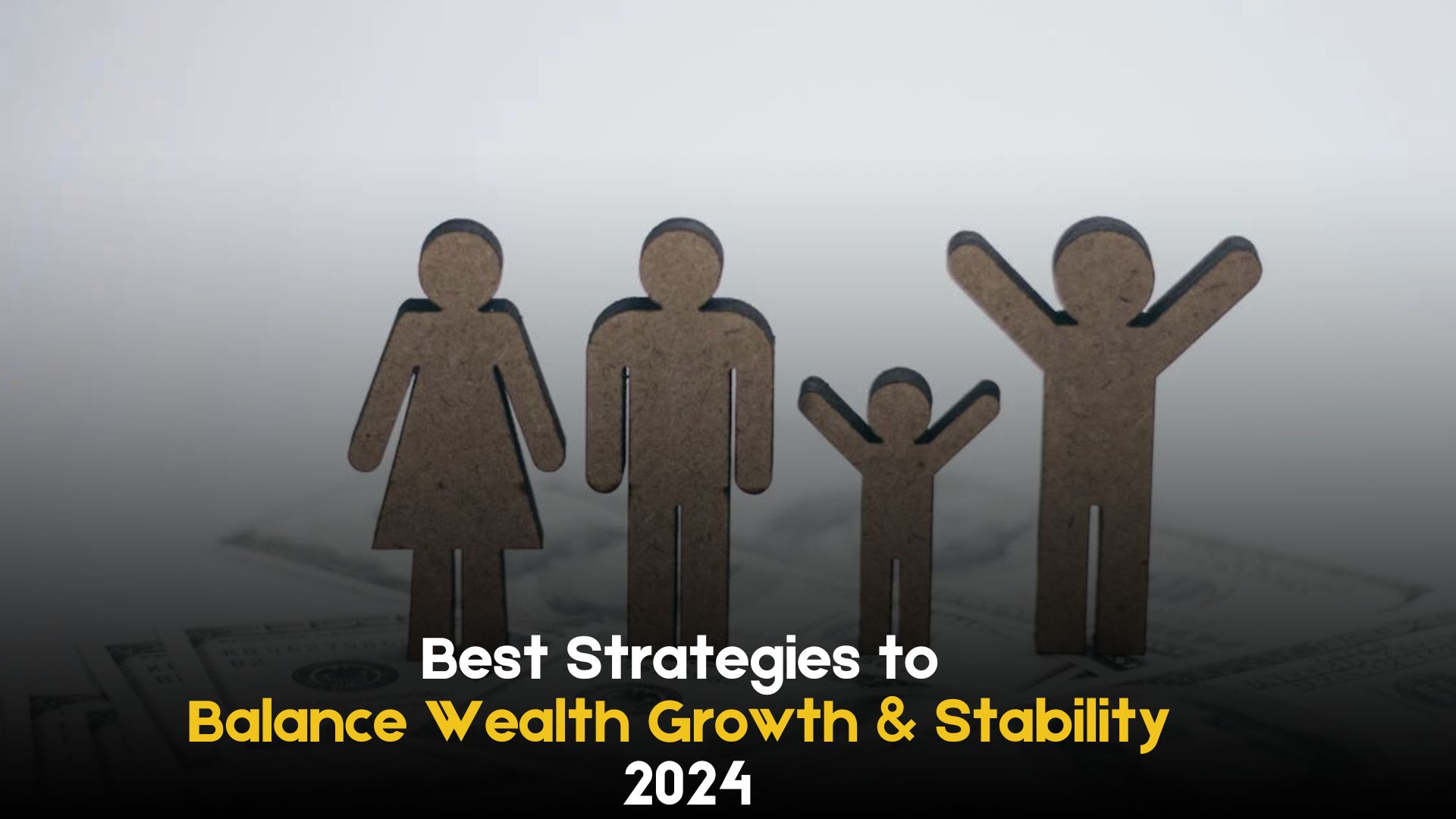In today’s dynamic economic world, striking a balance between increasing wealth and maintaining financial stability is a complex but critical task. As inflation, volatile stock markets, and other financial difficulties continue to affect individuals, the need for wise, strategic financial management grows.
In 2024, this balance is about generating money but simultaneously maintaining its security in an unpredictable world. Here, we look at crucial ways to help people balance these two important financial goals.
1. Create a Solid Financial Foundation

The first step toward balancing wealth growth and stability is to ensure that your finances are in order. This entails laying a solid financial foundation that can endure economic shocks while still allowing for expansion over time.
a) Build an Emergency Fund
Having an emergency fund is essential for stability. An emergency fund acts as a financial cushion, keeping you from tapping into your savings or incurring debt when unforeseen expenses arise. Aim for three to six months’ living expenses. This investment should be invested in a high-yield savings account or a money market account, which provides convenient access and growth potential.
b) Maintain Proper Insurance Coverage
Another important step toward financial security is to ensure that you have enough insurance coverage. This covers health, life, house, vehicle, and disability insurance. Insurance can shield you and your family from financial setbacks that would otherwise jeopardize your wealth-building efforts.
2. Adopt a Long-Term Investment Strategy
Long-term investing is an important method for increasing wealth while minimizing risk. Rather than seeking fast rewards, long-term investments can result in more consistent and substantial development.
a) Diversification is Key
Diversification is one of the safest strategies to increase wealth while minimizing risk. By diversifying your assets among asset classes such as stocks, bonds, real estate, and commodities, you can mitigate the impact of a single market decline. This method reduces volatility and guarantees that your portfolio grows consistently over time.
b) Invest in Index Funds and ETFs
Index funds and exchange-traded funds (ETFs) are popular long-term investment vehicles for people seeking both growth and stability. These funds monitor a broad market index, giving them exposure to a wide range of firms or assets, lowering risk while yet producing significant returns. They have historically outperformed actively managed funds due to lower expenses and greater diversification.
c) Focus on Dividend-Paying Stocks
Dividend-paying companies can be a great investment for people looking for stability and development. These companies generate consistent income through dividends, which may be reinvested to increase wealth over time. Dividend companies are also less volatile than non-dividend equities, so your portfolio will have a balance of growth and stability.
3. Maximize Tax Efficiency
Tax efficiency is an often overlooked yet critical component of balancing wealth growth and stability. The more you can lower your tax burden, the more you can invest for the future, allowing your wealth to expand steadily.
a) Utilize Tax-Advantaged Accounts
In 2024, it is critical to maximize contributions to tax-advantaged accounts like as 401(k), IRAs, and HSAs. These accounts enable your money to grow tax-deferred or tax-free, depending on the type of account. Reducing your taxable income today allows you to save more for the future while also lowering your tax burden.
b) Tax-Efficient Investing
Tax-efficient investing is selecting investments that pay the lowest possible taxes on capital gains, dividends, and interest. Municipal bonds are exempt from federal taxes, and long-term capital gains are taxed at a lower rate than short-term earnings. Understanding the tax implications of your investing decisions can help you retain more of your earnings and build wealth over time.
4. Debt Management: Prioritize Stability
While debt can be a useful tool for leveraging investment opportunities, it’s important to manage it carefully. High-interest debts, such as credit card balances, can quickly become a major burden, eroding your financial stability. Therefore, managing and eliminating debt should be a priority.
a) Use the Debt Avalanche Method
One effective way to eliminate debt while maintaining financial stability is the debt avalanche method. This strategy involves prioritizing high-interest debts first, while making minimum payments on others. By focusing on high-interest debts, you minimize the overall amount of interest you pay and accelerate your journey to debt freedom.
b) Consider Refinancing or Consolidation
If you have multiple debts with varying interest rates, consider consolidating them or refinancing them to secure a lower interest rate. This can make your debt more manageable and save you money in the long run, helping you keep your finances stable while still working toward wealth growth.
5. Set and Track Financial Goals

Setting clear financial goals is vital for balancing wealth growth and stability. Without specific goals, it’s easy to lose sight of your long-term financial objectives. Regularly reviewing your goals and progress can help you stay on track and make necessary adjustments along the way.
a) Short-Term and Long-Term Goals
Having a balance between short-term and long-term goals is key. Short-term goals might include building an emergency fund or paying off credit card debt, while long-term goals might involve saving for retirement or buying a home. By creating both types of goals, you ensure that you’re addressing immediate needs while planning for future financial security.
b) Regular Financial Reviews
Schedule regular check-ins to assess your progress toward your financial goals. Are you on track to meet your retirement target? Have you paid down debt? Reviewing your goals and financial health every quarter or year ensures that you can make adjustments to stay aligned with your objectives.
6. Focus on Consistent Income Streams
Balancing wealth growth with stability also involves diversifying your sources of income. Relying solely on one income stream can expose you to greater financial risk if that source is disrupted. By cultivating multiple income streams, you can grow your wealth while maintaining stability.
a) Side Hustles and Passive Income
In 2024, the gig economy offers various ways to earn supplemental income. Whether through freelance work, consulting, or starting an online business, side hustles can supplement your primary income and contribute to wealth growth. Additionally, passive income streams, such as rental income or dividends from investments, can help provide financial stability.
b) Build a Portfolio of Income-Producing Assets
Owning assets that generate regular income can help balance wealth growth and stability. Real estate, dividend stocks, and bonds are all examples of investments that generate steady income. By reinvesting the income generated from these assets, you continue to build wealth while preserving your financial stability.
7. Stay Informed and Adapt to Market Changes
The financial landscape is constantly evolving, so it’s crucial to stay informed about changes that could impact your wealth growth and stability. Whether it’s changes in tax laws, market trends, or economic shifts, staying adaptable and informed allows you to adjust your strategy as needed.
a) Continual Financial Education
Investing in your financial education ensures that you understand the best strategies for managing both growth and stability. Follow reputable financial news outlets, take courses, or consult with financial advisors to remain informed about the latest trends, tools, and strategies.
b) Adapt to Market Conditions
Sometimes, market conditions change in a way that requires a shift in your strategy. If markets become volatile, it might make sense to move a portion of your investments into more stable assets like bonds or cash equivalents. On the other hand, when markets are bullish, you may consider allocating more resources to equities for higher growth potential.
8. Maintain a Healthy Work-Life Balance

Finally, achieving a balance between wealth growth and stability is not just about money—it’s also about lifestyle. The pursuit of wealth should not come at the expense of your health or happiness. Maintaining a healthy work-life balance ensures that you’re not sacrificing your well-being for financial gain, ultimately contributing to long-term success in both your personal and financial life.
a) Avoid Burnout
While striving for financial success is important, overworking yourself can lead to burnout, negatively affecting your productivity and quality of life. Ensuring that you take time for self-care, family, and hobbies can provide the mental clarity needed to make better financial decisions.
b) Mindful Spending and Saving
Work-life balance also means managing your spending so you can save for both the present and the future. Practicing mindful spending ensures that your purchases align with your goals and values, supporting both your financial and emotional well-being.
Conclusion
Balancing wealth growth and financial stability in 2024 is not a one-time task but a continuous process. By building a strong financial foundation, investing strategically, managing debt effectively, setting clear goals, diversifying income streams, and staying informed, individuals can strike the delicate balance between growing their wealth and maintaining financial security. With a thoughtful, proactive approach, achieving financial success and stability is within reach for everyone.
Achieving the right balance between wealth growth and financial stability requires continuous assessment of your financial situation and regular adjustments based on changing circumstances. By implementing these strategies and remaining disciplined in your approach, you can build a secure financial future while achieving your wealth-building goals.




Leave a Comment